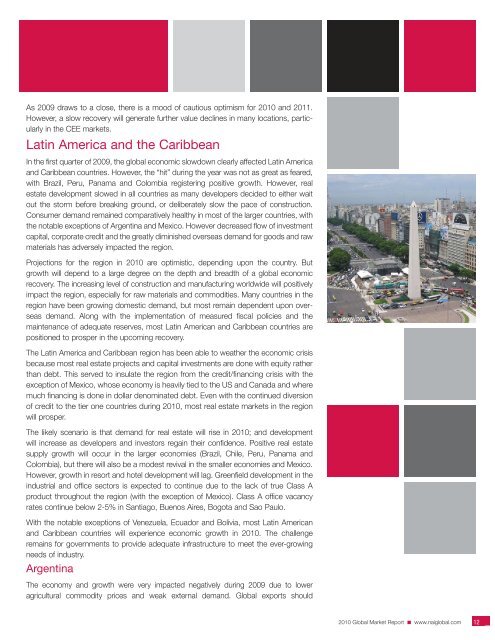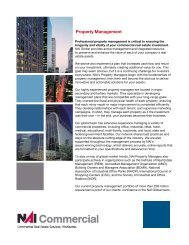Office rents have fallen across the region, with prime rents down by about 10% onaverage from mid-2008 to mid-2009. <strong>Market</strong>s in Austria, Germany (excluding Berlin),Switzerland and Netherlands have proven more resilient than others. Vienna, for example,has seen a 5% decline in rental values, whereas markets such as Dubai, Dublin, Tel-Aviv,London, Madrid, Moscow, Oslo and Warsaw have seen far more significant declines.Rents in Moscow and Kiev are off more than 50% from their peak. In virtually all markets,property owners are offering increased incentives, such as extended rent-free periods(several years in some markets), and contributions to fit-out costs.Retail rents, particularly in Western Europe, have withstood the recession better thanthose in the office sector. Rents have held steady in Austria, Belgium, France, Germany,Israel, Italy, The Netherlands, Portugal, Sweden, Switzerland and London (West End).However retailers, apart from select discounters and those in the food sector, haveplaced expansion plans on hold, and there have been some notable failures in thesector. As in previous recessions, the gap between prime and secondary space haswidened as retailers upgrade from secondary to prime locations. As in the office sector,development activity has been sharply curtailed, particularly in the Central and EasternEuropean (CEE) markets.The recession has also hit the warehouse/industrial sector. The most adversely affectedare Hungary, Ireland, Israel, Poland, Portugal, Russia, Spain, Ukraine and Dubai, all ofwhich experienced rental declines in excess of 20%. Most notably, industrial productionexperienced a 15% per annum decline, while retail volume dropped by 2.6% per annumthrough August 2009. Food and discount retailers are faring relatively well, but manyoccupiers are downsizing, seeking to rationalize their existing space. Industrial developmentactivity has virtually stopped across the continent.Investment volumes have fallen sharply across the region. In the first half of 2009,approximately €25 billion were invested in European property – a mere 20% of the corresponding2007 volume as institutional investors have adopted a wait-and-see attitude.Due to concerns about the security of income streams, buyers are exclusively seekingprime properties with long-term leases with notable transactions completed in France andthe UK. The latter has attracted some international investors, as values are expected torebound as economies bottom. German open-ended funds are slowly returning to themarket, but are restricting their search to prime, well-leased properties. Foreigninvestors are taking advantage of the weakness of the UK Pound, the availability of longterm leases with upward-only rent reviews and historically high yield levels. A shortageof prime stock is beginning to nudge yields down.Prime office yields have increased across the region, with the exception of Switzerland,though the rate of increase has slowed in the more mature western markets. In the UK,for example, yields in the City of London are now around 6.5%, an increase of 225 basispoints from the peak. Yields in London’s West End are now 5.25%, an increase of 175basis points. Current prime yields in Paris are around 5.75%, an increase of 215 basispoints. In Frankfurt they are 5.4%, an increase of 40 basis points. These corrections lookrelatively small compared with shifts of 650 and 450 basis points in Kiev and Moscow,respectively. The focus of investors on prime sector properties has widened the gapbetween the prime and secondary yields.<strong>2010</strong> <strong>Global</strong> <strong>Market</strong> <strong>Report</strong> ■ www.naiglobal.com11
As 2009 draws to a close, there is a mood of cautious optimism for <strong>2010</strong> and 2011.However, a slow recovery will generate further value declines in many locations, particularlyin the CEE markets.Latin America and the CaribbeanIn the first quarter of 2009, the global economic slowdown clearly affected Latin Americaand Caribbean countries. However, the “hit” during the year was not as great as feared,with Brazil, Peru, Panama and Colombia registering positive growth. However, realestate development slowed in all countries as many developers decided to either waitout the storm before breaking ground, or deliberately slow the pace of construction.Consumer demand remained comparatively healthy in most of the larger countries, withthe notable exceptions of Argentina and Mexico. However decreased flow of investmentcapital, corporate credit and the greatly diminished overseas demand for goods and rawmaterials has adversely impacted the region.Projections for the region in <strong>2010</strong> are optimistic, depending upon the country. Butgrowth will depend to a large degree on the depth and breadth of a global economicrecovery. The increasing level of construction and manufacturing worldwide will positivelyimpact the region, especially for raw materials and commodities. Many countries in theregion have been growing domestic demand, but most remain dependent upon overseasdemand. Along with the implementation of measured fiscal policies and themaintenance of adequate reserves, most Latin American and Caribbean countries arepositioned to prosper in the upcoming recovery.The Latin America and Caribbean region has been able to weather the economic crisisbecause most real estate projects and capital investments are done with equity ratherthan debt. This served to insulate the region from the credit/financing crisis with theexception of Mexico, whose economy is heavily tied to the US and Canada and wheremuch financing is done in dollar denominated debt. Even with the continued diversionof credit to the tier one countries during <strong>2010</strong>, most real estate markets in the regionwill prosper.The likely scenario is that demand for real estate will rise in <strong>2010</strong>; and developmentwill increase as developers and investors regain their confidence. Positive real estatesupply growth will occur in the larger economies (Brazil, Chile, Peru, Panama andColombia), but there will also be a modest revival in the smaller economies and Mexico.However, growth in resort and hotel development will lag. Greenfield development in theindustrial and office sectors is expected to continue due to the lack of true Class Aproduct throughout the region (with the exception of Mexico). Class A office vacancyrates continue below 2-5% in Santiago, Buenos Aires, Bogota and Sao Paulo.With the notable exceptions of Venezuela, Ecuador and Bolivia, most Latin Americanand Caribbean countries will experience economic growth in <strong>2010</strong>. The challengeremains for governments to provide adequate infrastructure to meet the ever-growingneeds of industry.ArgentinaThe economy and growth were very impacted negatively during 2009 due to loweragricultural commodity prices and weak external demand. <strong>Global</strong> exports should<strong>2010</strong> <strong>Global</strong> <strong>Market</strong> <strong>Report</strong> ■ www.naiglobal.com12
- Page 1 and 2: CommercialCommercial Real Estate Se
- Page 3 and 4: ■ ■ ■ Table of ContentsGENERA
- Page 5 and 6: Global OutlookCommercial real estat
- Page 7 and 8: 38.3% in November 2009. At the same
- Page 9 and 10: quality than the Census properties.
- Page 11: SaskatchewanSaskatchewan is a small
- Page 15 and 16: Global investment interest largely
- Page 18 and 19: ChinaChina continued to post large
- Page 20 and 21: MalaysiaWith Malaysia’s dependenc
- Page 22 and 23: ■ US Highlights - Northeast Regio
- Page 24 and 25: ■ US Highlights - Midwest Region
- Page 26 and 27: ■ US Highlights - West Region■
- Page 28 and 29: Melbourne, AustraliaBeijing, ChinaC
- Page 30 and 31: Shanghai, ChinaXiamen, ChinaContact
- Page 32 and 33: Delhi, Gurgaon, IndiaHyderabad, Pra
- Page 34 and 35: Punjab, IndiaTokyo, JapanContactNAI
- Page 36 and 37: Seoul, South KoreaTaipei, TaiwanCon
- Page 38 and 39: Calgary, Alberta, CanadaEdmonton, A
- Page 40 and 41: Halifax, Nova Scotia, CanadaOttawa,
- Page 42 and 43: Regina, Saskatchewan, CanadaContact
- Page 44 and 45: Vienna, AustriaThe Baltics (Latvia/
- Page 46 and 47: Copenhagen, DenmarkFinlandContactNA
- Page 48 and 49: Athens, GreeceReykjavik IcelandCont
- Page 50 and 51: KuwaitOslo, NorwayContactNAI Kuwait
- Page 52 and 53: Moscow, Russian FederationSt. Peter
- Page 54 and 55: Madrid, SpainStockholm, SwedenConta
- Page 56 and 57: Istanbul, TurkeyKiev, UkraineContac
- Page 58 and 59: Latin AmericaSECTION CONTENTSBuenos
- Page 60 and 61: Campinas, BrazilCuritiba, BrazilCon
- Page 62 and 63:
Sao Paulo, BrazilSantiago, ChileCon
- Page 64 and 65:
Ciudad Juarez, Chihuahua, MexicoGua
- Page 66 and 67:
Matamoros, Tamaulipas, MexicoMexica
- Page 68 and 69:
Reynosa, MexicoSaltillo, Coahuila,
- Page 70 and 71:
Torreon, Coahulia, MexicoCaracas, V
- Page 72 and 73:
Birmingham, AlabamaHuntsville, Deca
- Page 74 and 75:
Jonesboro, ArkansasLittle Rock, Ark
- Page 76 and 77:
Marin County, CaliforniaMonterey, C
- Page 78 and 79:
Sacramento, CaliforniaSan Diego, Ca
- Page 80 and 81:
Santa Clara County (Silicon Valley)
- Page 82 and 83:
Colorado Springs, ColoradoDenver, C
- Page 84 and 85:
Fort Lauderdale, FloridaFt. Myers/N
- Page 86 and 87:
Miami, FloridaOrlando, FloridaConta
- Page 88 and 89:
Atlanta, GeorgiaHonolulu, HawaiiCon
- Page 90 and 91:
Chicago, IllinoisSpringfield, Illin
- Page 92 and 93:
Cedar Rapids, Iowa City, IowaDavenp
- Page 94 and 95:
Wichita, KansasLexington, KentuckyC
- Page 96 and 97:
Monroe, LouisianaNew Orleans, Louis
- Page 98 and 99:
Suburban MarylandBoston, Massachuse
- Page 100 and 101:
Grand Rapids, MichiganLansing, Mich
- Page 102 and 103:
St. Louis, MissouriBozeman, Montana
- Page 104 and 105:
Omaha, NebraskaLas Vegas, NevadaCon
- Page 106 and 107:
Portsmouth, New HampshireAtlantic C
- Page 108 and 109:
Ocean/Monmouth Counties (“Shore M
- Page 110 and 111:
Las Cruces, New MexicoAlbany, New Y
- Page 112 and 113:
Asheville, North CarolinaCharlotte,
- Page 114 and 115:
Fargo, North DakotaAkron, OhioConta
- Page 116 and 117:
Cleveland, OhioColumbus, OhioContac
- Page 118 and 119:
Tulsa, OklahomaPortland, OregonCont
- Page 120 and 121:
Bucks County, PennsylvaniaHarrisbur
- Page 122 and 123:
Pittsburgh, PennsylvaniaSchuylkill
- Page 124 and 125:
Greenville/Spartanburg/Anderson Cou
- Page 126 and 127:
Knoxville, TennesseeMemphis, Tennes
- Page 128 and 129:
Beaumont, TexasCorpus Christi, Texa
- Page 130 and 131:
Fort Worth, TexasHouston, TexasCont
- Page 132 and 133:
Texarkana (Bowie County, Texas/Mill
- Page 134 and 135:
Northern VirginiaSeattle/Puget Soun
- Page 136 and 137:
Madison, WisconsinMilwaukee, Wiscon
- Page 138 and 139:
Jackson Hole, WyomingContactNAI Jac
- Page 140:
Build on the power of our network.N





